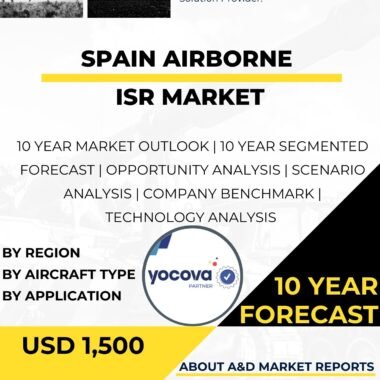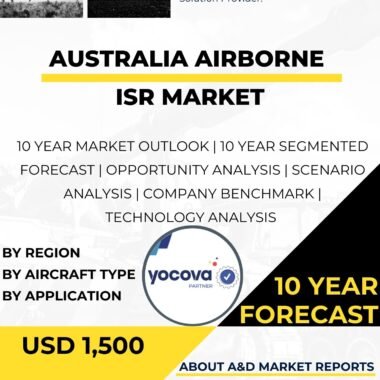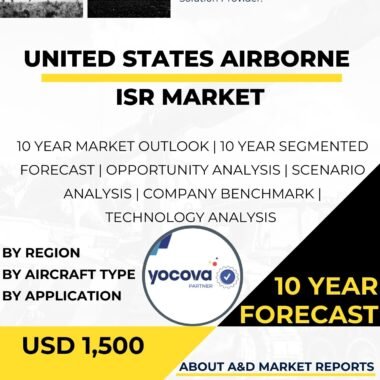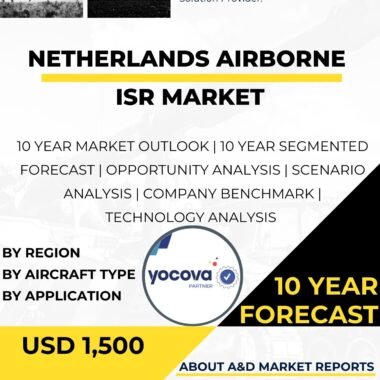Description
Germany Airborne ISR Market
The Germany Airborne Intelligence, Surveillance, and Reconnaissance (ISR) Market is a critical and rapidly evolving segment within the country’s defense industry. It focuses on the development, production, and deployment of advanced airborne ISR systems to enhance Germany’s situational awareness, intelligence gathering capabilities, and operational effectiveness. Airborne ISR refers to the use of airborne platforms, such as reconnaissance aircraft, unmanned aerial vehicles (UAVs), and helicopters, equipped with sensors and cameras to collect and analyze critical data for military and security purposes. The adoption of Germany airborne ISR Market is driven by several key factors. Foremost among them is the need to enhance the country’s intelligence capabilities and maintain a comprehensive understanding of the evolving security landscape. In an increasingly complex and dynamic security environment, access to real-time and accurate intelligence is essential for making informed decisions and responding effectively to emerging threats.
Moreover, the Germany Airborne ISR Market has witnessed significant advancements in technology, including the development of high-resolution sensors, electro-optical/infrared (EO/IR) cameras, synthetic aperture radar (SAR), and signals intelligence (SIGINT) systems. These technological innovations have opened up new possibilities for airborne ISR systems, enabling German defense forces to gather intelligence across various domains, including land, maritime, and cyberspace.
The German government’s focus on modernizing its defense capabilities and maintaining a technologically advanced military plays a pivotal role in driving the growth of the domestic Airborne ISR Market. Germany recognizes the strategic importance of investing in airborne ISR capabilities to maintain its edge in intelligence gathering and ensure national security.
The Germany Airborne ISR Market also benefits from partnerships and collaborations with international defense companies. Joint ventures, technology transfers, and knowledge-sharing agreements enable German defense manufacturers to access global expertise and best practices, accelerating the development and deployment of advanced airborne ISR systems.
A core objective of the Germany Airborne ISR Market is to enhance Germany’s situational awareness and intelligence collection capabilities. Airborne ISR systems provide critical information about enemy activities, potential threats, and other relevant data that supports military planning and decision-making processes.
The adoption of airborne ISR systems offers several benefits for Germany’s defense and security forces. First and foremost, it improves the country’s ability to detect and respond to potential threats in real-time. Airborne ISR platforms equipped with advanced sensors and cameras can provide continuous surveillance and reconnaissance, offering valuable insights into enemy movements and activities.
Furthermore, airborne ISR systems enhance the effectiveness of military operations. The real-time intelligence provided by airborne ISR platforms allows commanders to make informed decisions, coordinate forces more effectively, and maintain a tactical advantage over adversaries.
Additionally, the Germany Airborne ISR Market supports the growth of the domestic defense industry and fosters technological innovation. The development and production of airborne ISR systems require specialized engineering skills, advanced materials, and manufacturing capabilities. As the domestic defense industry invests in these areas, it fosters job creation, skill development, and economic growth.
However, the Germany Airborne ISR Market also faces certain challenges. One significant hurdle is the complexity and cost associated with developing and acquiring advanced ISR systems. These cutting-edge defense technologies require substantial investments in research, development, and production, which may pose financial constraints for the defense budget.
Moreover, there are technical and operational considerations that need to be addressed when deploying airborne ISR systems. Ensuring seamless integration with other defense assets, such as command and control centers and ground-based systems, is crucial to maximize the effectiveness of airborne ISR platforms.
Looking ahead, the Germany Airborne ISR Market is expected to witness continued growth and innovation. As defense technology continues to evolve, airborne ISR systems will become more sophisticated, versatile, and capable of gathering intelligence across multiple domains.
The German government’s commitment to investing in advanced ISR capabilities and fostering collaboration with defense industry partners will be instrumental in driving the adoption and deployment of cutting-edge airborne ISR systems.
In conclusion, the Germany Airborne ISR Market is a critical and rapidly evolving segment with significant implications for the country’s defense capabilities and intelligence gathering capabilities. With a focus on innovation, research, and collaboration, the German defense industry is poised to become a key player in harnessing the power of airborne ISR technology. Additionally, by adopting advanced ISR systems, Germany can enhance its situational awareness, intelligence gathering capabilities, and operational effectiveness, thereby bolstering national security and contributing to the safety and well-being of its citizens. As airborne ISR technology continues to advance, the Germany Airborne ISR Market will play a pivotal role in shaping the future of intelligence gathering and military preparedness in the country.




